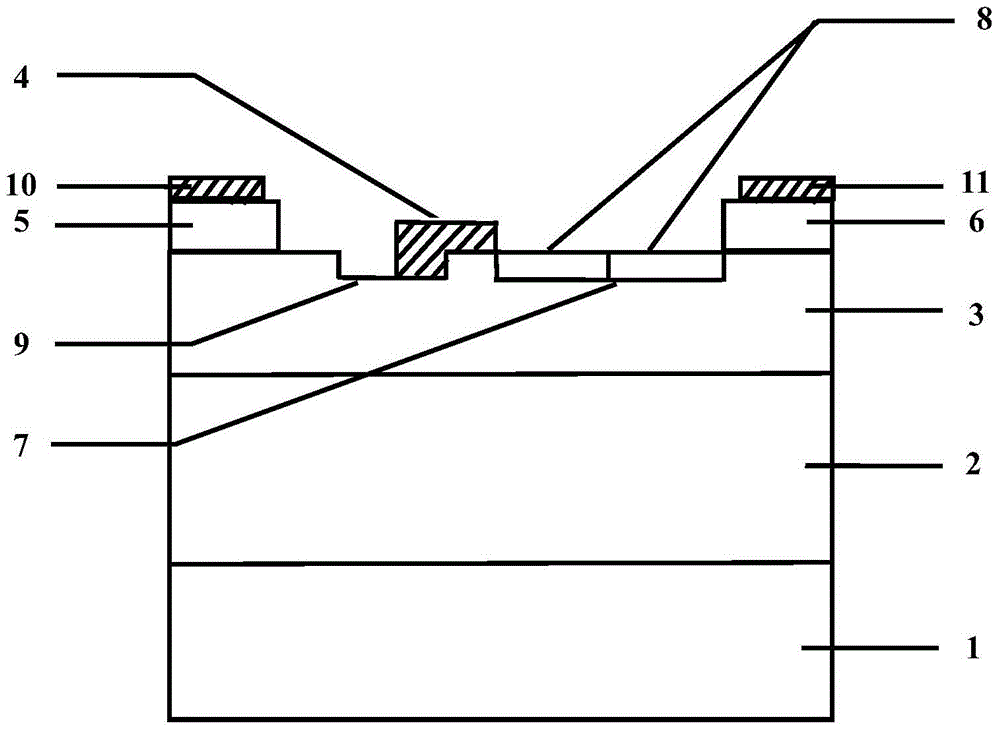4h-sic Metal Semiconductor Field Effect Transistor
A technology of field effect transistors and metal semiconductors, applied in the field of field effect transistors, can solve problems such as saturation current degradation, drain current reduction, lattice damage, etc.
- Summary
- Abstract
- Description
- Claims
- Application Information
AI Technical Summary
Problems solved by technology
Method used
Image
Examples
Embodiment 1
[0036] Example 1: Fabricate a 4H-SiC metal-semiconductor field-effect transistor with a PN junction with a thickness of 0.04 μm and a P region length of 0.45 μm.
[0037] The manufacturing steps of this embodiment are as follows:
[0038] Step 1: Clean the 4H-SiC semi-insulating substrate to clean the surface.
[0039] (1.1) Carefully clean the substrate twice with a cotton ball dipped in methanol;
[0040] (1.2) Wash the substrate in xylene at 80°C, boiling acetone and methanol at 80°C for 4 minutes, then blow dry with dry high-purity nitrogen;
[0041] (1.3) Place the substrate in H 2 SO 4 with H 2 o 2 After soaking in the mixed solution with a ratio of 1:1 for 10 minutes, rinse twice with deionized water, and finally dry the substrate with nitrogen.
[0042] Step 2: epitaxially grow a SiC layer on the surface of the 4H-SiC semi-insulating substrate, and form a P-type buffer layer by boron in-situ doping.
[0043] Put the 4H‐SiC semi-insulating substrate into the grow...
Embodiment 2
[0076] Example 2: Fabricate a 4H-SiC metal-semiconductor field-effect transistor with a PN junction with a thickness of 0.05 μm and a P region length of 0.5 μm.
[0077] The manufacturing steps of this embodiment are as follows:
[0078] Step 1: Same as Step 1 of Example 1.
[0079] Step 2: Same as Step 2 of Example 1.
[0080] Step 3: Same as Step 3 of Example 1.
[0081] Step 4: Same as Step 4 of Example 1.
[0082] Step 5: Same as Step 5 of Example 1.
[0083] Step 6: Same as Step 6 of Example 1.
[0084] Step 7: Same as Step 7 of Example 1.
[0085] Step 8: Same as Step 8 of Example 1.
[0086] Step 9: Epitaxial N on the surface of the recessed gate drain drift region ‐ SiC layer.
[0087] Simultaneously feed silane at a flow rate of 20ml / min, propane at 10ml / min, high-purity hydrogen at 80l / min and high-purity nitrogen at 2ml / min in the growth chamber at a growth temperature of 1550°C and a pressure of 10 5 Under the condition of Pa for 36s, grow 0.05μm thick N ...
Embodiment 3
[0094] Example 3: Fabricate a 4H-SiC metal-semiconductor field-effect transistor with a PN junction with a thickness of 0.045 μm and a P region length of 0.48 μm.
[0095] The manufacturing steps of this embodiment are as follows:
[0096] Step A: Same as Step 1 of Example 1.
[0097] Step B: Same as Step 2 of Example 1.
[0098] Step C: Same as Step 3 of Example 1.
[0099] Step D: Same as Step 4 of Example 1.
[0100] Step E: Same as Step 5 of Example 1.
[0101] Step F: Same as Step 6 of Example 1.
[0102] Step G: Same as Step 7 of Example 1.
[0103] Step H: Same as Step 8 of Example 1.
[0104] Step I: Epitaxial N on the surface of the recessed gate drain drift region ‐ SiC layer.
[0105] Simultaneously feed silane at a flow rate of 20ml / min, propane at 10ml / min, high-purity hydrogen at 80l / min and high-purity nitrogen at 2ml / min in the growth chamber at a growth temperature of 1550°C and a pressure of 10 5 Under the condition of Pa for 33s, the growth of 0.045...
PUM
 Login to View More
Login to View More Abstract
Description
Claims
Application Information
 Login to View More
Login to View More - R&D
- Intellectual Property
- Life Sciences
- Materials
- Tech Scout
- Unparalleled Data Quality
- Higher Quality Content
- 60% Fewer Hallucinations
Browse by: Latest US Patents, China's latest patents, Technical Efficacy Thesaurus, Application Domain, Technology Topic, Popular Technical Reports.
© 2025 PatSnap. All rights reserved.Legal|Privacy policy|Modern Slavery Act Transparency Statement|Sitemap|About US| Contact US: help@patsnap.com


